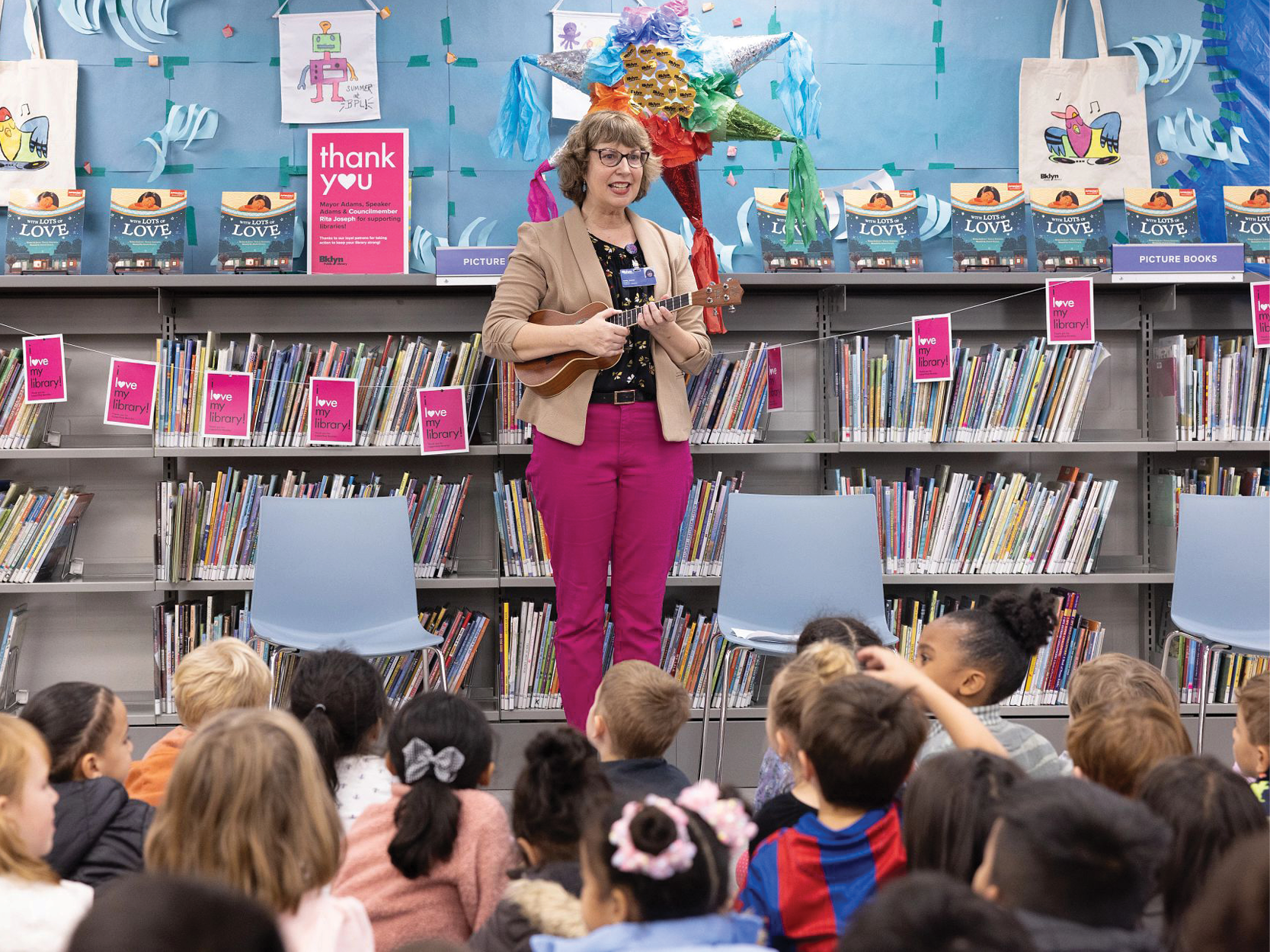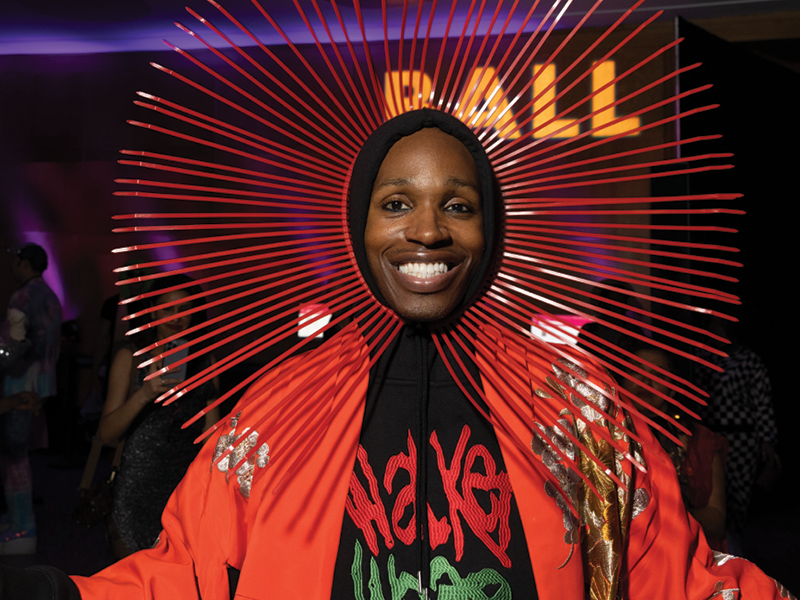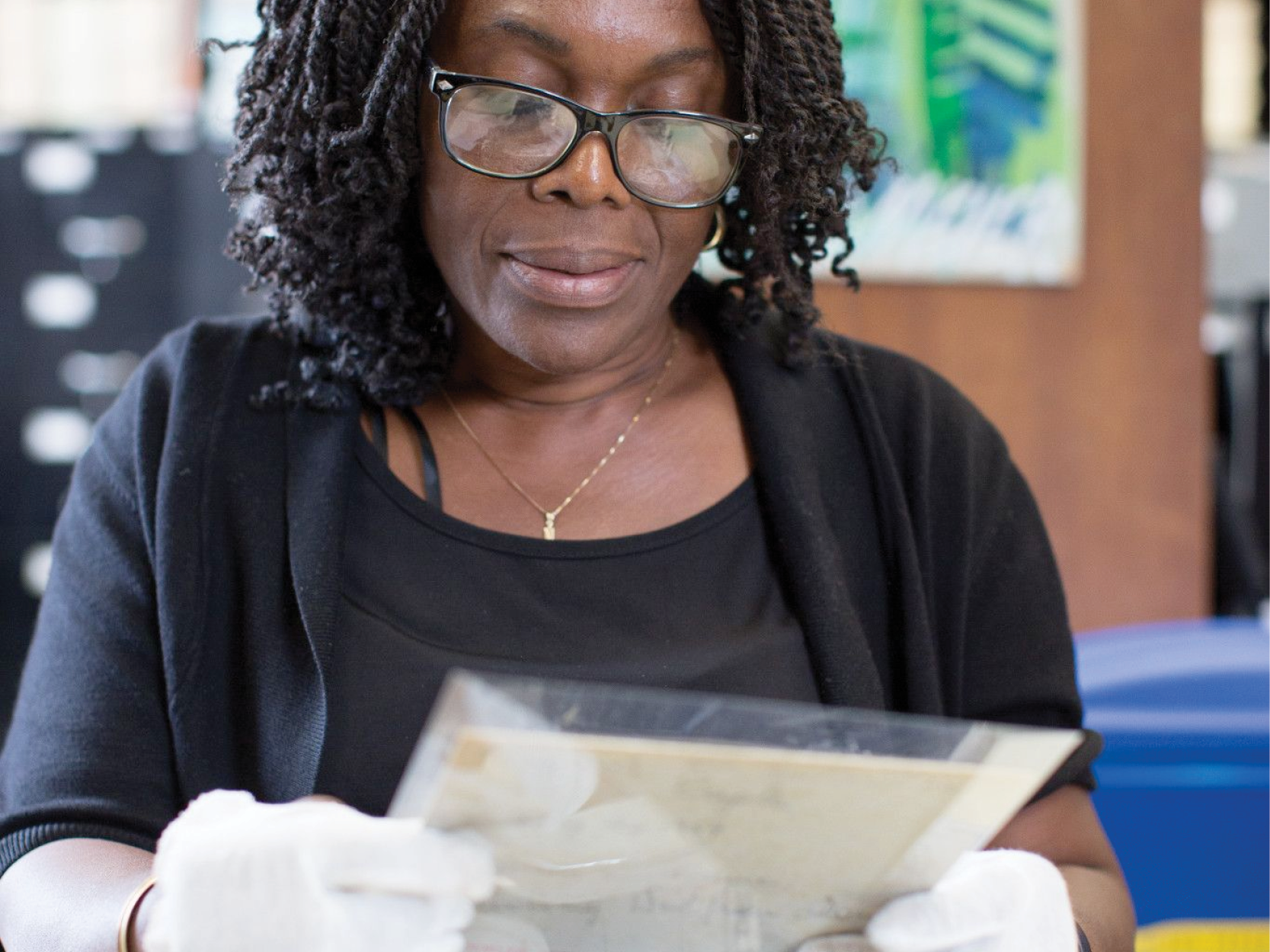Funded in Part through the Greenpoint Community Environmental Fund, The Library Will be a Home for Environmental Education for all of Brooklyn as Well as a Full-Time Working Library for Greenpoint
This is the First Major Opening in the Rebuilding of BPL’s Libraries; One Third of BPL’s Branches are Slated for Revitalization or Redevelopment in the Next Five Years

Brooklyn, NY – The new Greenpoint Library and Environmental Education Center is open for business, Brooklyn Public Library leadership announced today at a socially-distant celebration outside the branch.
Designed by Marble Fairbanks, with landscape architecture by SCAPE, the library is twice the size of the previous branch, encompassing more than 15,000 square feet with significantly enlarged indoor and outdoor spaces for both everyday library services and expanded activities for the exploration of the environment. See photos of the new library here.
Although the Coronavirus has initially limited the library to grab-and-go service, the opening of the branch to patrons nonetheless represents a major milestone in BPL’s effort to redevelop or revitalize a third of its branches, as part of the largest slate of rebuilding Brooklyn’s libraries since the Carnegie era.
"The new Greenpoint Library models the enormous potential of public libraries in the 21st century,” said Linda E. Johnson, President and CEO of Brooklyn Public Library. “With the help of our partners, from the Greenpoint Community Environmental Fund to Marble Fairbanks, we created a space for everyone in the community that is as inspiring as it is versatile. In 2020, in Brooklyn and beyond, we need more libraries like this one: that make vital knowledge and beautiful design accessible to all, that empower people from all walks of life to come together and build a more sustainable, more just world."
“Libraries are a great equalizer in New York City, and we’re proud to support dynamic, beautiful, and environmentally sound spaces for the next generation of Brooklynites to learn,” said New York City Mayor Bill de Blasio. “The Greenpoint Library and Environmental Education Center will be more than an essential free, high-quality resource for families – it will be a bulwark in our fight against climate change and an anchor for this iconic neighborhood for years to come.”
“Created by money obtained by the State from ExxonMobil for its devastating oil spill, The Greenpoint Community Environmental Fund aims to help reverse a legacy of environmental abuse and neglect in the Greenpoint community,” said New York State Attorney General Letitia James. “The new Greenpoint Library and Environmental Education Center, which received major support from the Fund, is an essential institution that will provide environmental understanding, appreciation, and engagement in the community for generations to come.”
“Congratulations to Brooklyn Public Library and to the Greenpoint community on the opening of the Greenpoint Library and Environmental Education Center. It has been our distinct honor to lead the design team in bringing the vision for this branch library to a built reality. Focused on environmental education, the Greenpoint branch offers greatly expanded spaces for the public and is, itself, a demonstration of sustainable and resilient design. Its mission as a branch library providing critical social resources to Greenpoint was augmented by impactful, community-based environmental organizations that became integral partners in the design process. We hope this building inspires joyful learning, sustains community health and wellness, provides vital spaces for civic gathering and personal growth, and supports future activists focused on climate change and the environment,” said Karen Fairbanks, Marble Fairbanks Architects.
The new building – which is targeting LEED Platinum certification – represents the most modern thinking about the way that libraries are used by patrons today with flexible spaces that can be used for solo study, small group work or larger meetings; enough electrical outlets and laptop space for tech-enabled work; and even a dedicated space for teens, whose needs were under-met in previous decades with the traditional library layout of children’s reading rooms and adult spaces.
The library also includes lab spaces for interactive projects, a large community event space, lounge seating, small meeting rooms and outdoor spaces--including reading and demonstration gardens and a first floor plaza–for programs and more.
“We’ve found there’s no substitute for learning directly from the landscape,” said Gena Wirth, Design Principal at SCAPE. “On all three stories, the Library carves out space for hands-on encounters with the geological, ecological, and cultural history of Greenpoint. The plaza and gardens are designed to be accessible for all Library patrons in years to come – from child-sized spaces for planting and play to richly-detailed civic spaces for shared use, programs, and continued education.”
Funded with $5 million provided by the Office of the New York State Attorney General and New York State Department of Environmental Conservation through the Greenpoint Community Environmental Fund, as well as $18 million in other sources including the City of New York, the New York City Council, Borough President Adams, Assemblymember Joe Lentol and the New York State Department of Education, the library will in part be dedicated to environmental education, activism and awareness serving all who share a passion not just for protecting the environment but for building a safe and sustainable world.
The physical space itself–which is replete with details that bring the natural world to patrons’ fingertips – will serve as a teaching tool:
Outside, on the plaza, a bioswale – a channel designed to convey and store rainwater runoff – will help reduce flooding and avert pollutants from our waterways into the ground below, and help teach about physical preparedness for climate change;
Glacial outcroppings in front of the library will help interpret the geological history of the area, telling the story of glacial erratics, tracing the NW to SE of the Laurentide Ice Sheet during its expansion across Brooklyn approximately 18,000 years ago;
The large, open spaces inside the library utilize displacement ventilation, a highly-efficient heating and cooling system that introduces a large amount of air into the space at a low velocity; our bodies attract the air, creating individualized “thermal plumes” around each person, delivering fresh air efficiently through all seasons;
Four windows on the first floor provide a way to learn about the sun and the seasons. At exactly 12 p.m., during the solstices and the equinoxes, light shines perfectly into these rectangular windows and onto the floor;
The library’s three meeting rooms bring the outdoors inside: each room features a wood wall containing the different species of trees native to the Greenpoint neighborhood- ash, walnut, and red oak. All of the wood used in the library is Forest Stewardship Council-certified;
The second floor reading garden is a place for talks and performances or to enjoy a book in the sunshine. A large sculpted planting bed surrounds the area with native and fruit-bearing shrubs, offering both food and a critical habitat for birds and insects, who in turn, distribute the seeds throughout the neighborhood;
A second-floor cistern can capture and store up to 1,500 gallons of rainwater, which the library will use for lab experiments and to water the plants on both the second and third floor -- helping divert rain water from the sewer system and reduce tap water usage. Rainwater not held here will flow from the roofs down to the plaza below and filter through the bioswale or drain into a detention tank;
An interactive, educational energy use tracking screen on the second floor will showcase the building’s energy usage in real time, and the energy generated by the solar panels;
Installed on a canopy structure above mechanical equipment, the library’s solar panel modules can collect over 15 kilowatts of energy at once, just from sunlight. Over the course of one year, they can produce over 19,000 kilowatts, which help power the library. The modules are bifacial, meaning they can collect energy from both sides of the panel: sunlight from above and from light reflected off the roof;
A ‘demonstration garden’ on the roof can be used by students and community groups in the area, who will choose, alongside library staff, what and when to plant, and will help take care of the plants throughout the year, watching the plant life cycle in real time. Surrounding the demonstration area, a pollinator garden is planted with sedum beds that evoke the neighborhood's agricultural history.
Other environmental elements of the building include energy-efficient lighting, including LED lights and light sensors on the lower level; use of energy-efficient glazing, solar shading devices, well-insulated enclosure panels and materials; use of sustainable, durable interior finishes with low VOC emissions and high non-toxic recycled content; and reduction of indoor and outdoor water consumption by using only WaterSense label low-flow plumbing fixtures.
The library will also highlight the Greenpoint Environmental History Project, dedicated to documenting and preserving the environmental history of Greenpoint through oral histories and community scanning. All of the collected documents, images, and oral history recordings are available online as part of BPL's digital collection; oral histories are also available on SoundCloud and the Our Streets, Our Stories Tumblr.
Developed as a unique community partnership, the Greenpoint Library and Environmental Education Center is also a key example of how libraries are using creative funding mechanisms to deliver libraries whose resources are catered to local communities:
-In Brooklyn Heights, the library partnered with Hudson Companies to deliver a dramatically-expanded, more modern library for the local community anchoring a mixed-use building, helping close its capital needs gap systemwide and bring online a brand new neighborhood branch in DUMBO/Farragut;
-In Sunset Park, BPL is working with the Fifth Avenue Committee to deliver a modern branch nearly twice the size of the previous one, with enough family space and multilingual materials for one of the busiest branches in the system, as well as affordable housing for local residents and survivors of domestic violence;
-In Crown Heights, the library is partnering with the Brooklyn Children’s Museum to move its Brower Park branch, to the Museum – helping to supplement BCM’s existing educational efforts for Brooklyn’s children.
Environmental advocates, local elected officials and others praised the Greenpoint Library’s opening:
"I am thrilled to be a part of the opening of the Greenpoint Library and Environmental Education Centers," said Congresswoman Carolyn B. Maloney. "As a former New York City public school teacher and a longtime supporter of this project, I know just how important access to public libraries is to students and everyday New Yorkers. This library will provide critical access to books and environmental education here in Greenpoint, a neighborhood long burdened with the toxic legacy of our nation's industrial past."
"Congratulations to the Brooklyn Public Library on the opening of their new Greenpoint branch. The center's commitment to environmental education, showcased by their sustainable design features and interactive spaces, is especially significant as our city faces a future of increasingly frequent storms, coastal flooding, extreme heat waves, and other effects of climate change,” said Brooklyn Borough President Eric Adams. “As someone who believes in the value of hands-on educational opportunities for children, as well as neighborhood spaces that help to educate and engage us as empowered communities, I am excited to see all that this library will bring to the families of Greenpoint."
“The opening of the Greenpoint Library and Environmental Education Center is cause for celebration and excitement. The new library will be a wonderful addition to North Brooklyn and will serve as a vital educational resource and community gathering place, while promoting a greater appreciation for the environment,” said State Senator Brian Kavanagh. “I look forward to seeing the many ways the community will enjoy the new library, with its expert craftsmanship and thoughtful design, and the wealth of information and programming that it will offer. I commend all of those involved with the creation of this new Greenpoint gem.”
“The Greenpoint Library and Environmental Education Center will be a gateway to knowledge for Greenpoint residents and beyond. This library and the Environmental Education Center sets the tone for our neighborhood's future. Congratulations to everyone who has worked to make this project a reality - let's get this library open and let's start reading,” said Assembly Member Joseph R. Lentol (D-North Brooklyn).
“The City Council congratulates the Brooklyn Public Library on the opening of the Greenpoint Libriary and Environmental Education Center. Our public library systems have shown to be more vital than ever during this pandemic and we are proud to support this expansion, which prioritizes environmental sustainability. The environmental education center will serve as an important community resource for educating New Yorkers of all ages on the impacts of climate change and how to best protect the environment. I look forward to seeing Brooklyn residents and all New Yorkers enjoying this new facility for years to come,” said New York City Council Speaker Corey Johnson.
“Greenpoint is finally getting the library it deserves. In this time of uncertainty and hardship, there could be no better symbol of hope and the future than opening this long-awaited environmentally-themed library,” said City Council Member Stephen Levin. “I want to thank GCEF for their funding of the project, especially Peter Washburn and Laura Treikocas, Dewey Thompson for bringing the idea to the Brooklyn Public Library, the Community Advisory Committee for overseeing the construction, and of course, all the community members who have worked so hard to bring this to fruition. This is the time that we need a cultural institution such as this library dedicated to environmental issues. Where kids and families can come to learn about the history of Greenpoint and understand the wonders of nature and how we are interconnected with the natural world around us. I look forward to bringing my children here for many years to come.”
Support for technology and internet service provided by the Spectrum Learning Lab program.
“This is a transformational change for the Brooklyn Public Library,” said Rodney Capel, vice president of Government Affairs for Spectrum. “The focus on our environment and conservation serves as a meaningful addition to the BPL members. We are proud, too, of our longstanding partnership with the Library. Our Spectrum Learning Labs, located at both the Greenpoint and Bushwick branches, enhance online learning for area residents, and will play a pivotal role to assist the library in its mission to educate, explore and entertain Brooklyn residents.”
About Brooklyn Public Library
Brooklyn Public Library is one of the nation’s largest library systems and among New York City’s most democratic institutions. As a leader in developing modern 21st century libraries, we provide resources to support personal advancement, foster civic literacy, and strengthen the fabric of community among the more than 2.6 million individuals who call Brooklyn home. We provide nearly 65,000 free programs a year with writers, thinkers, artists, and educators—from around the corner and around the world. And we give patrons millions of opportunities to enjoy one of life’s greatest satisfactions: the joy of a good book.







